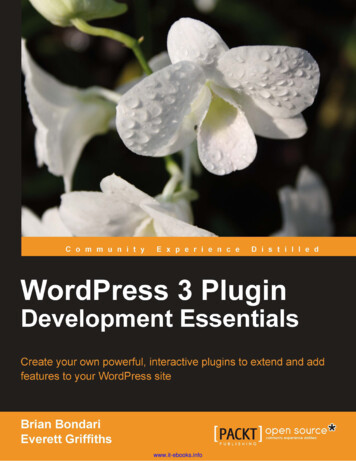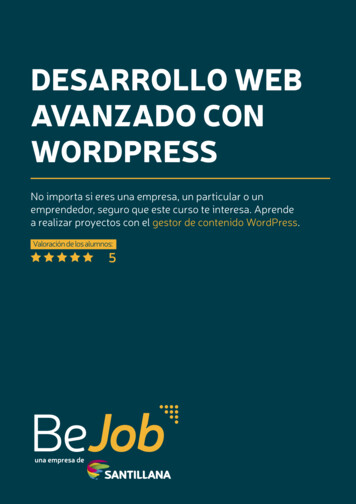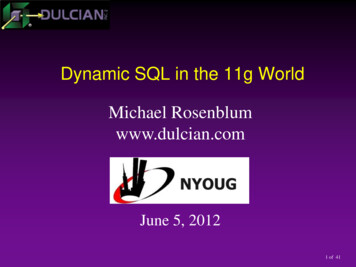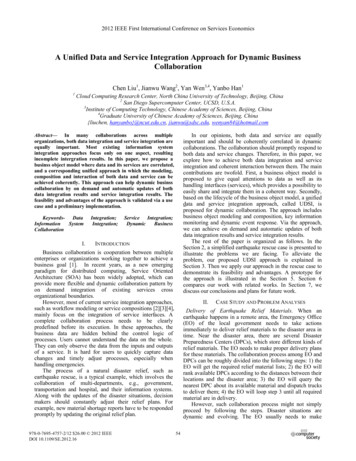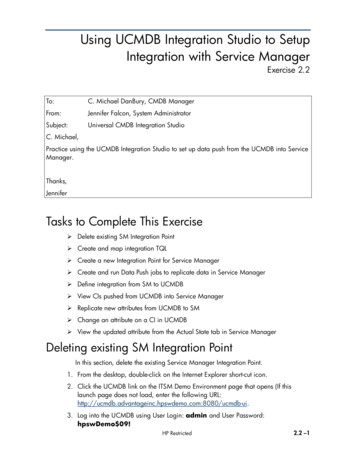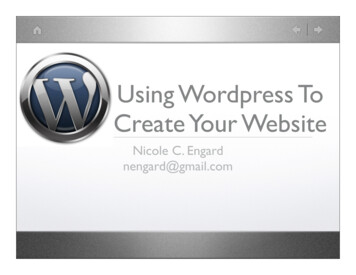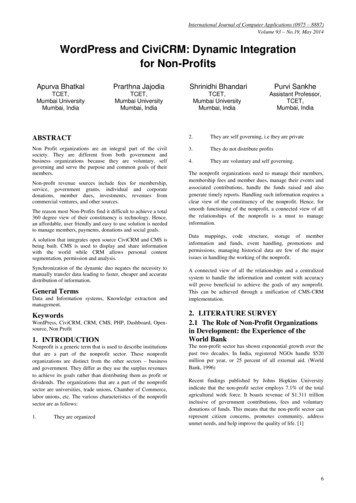
Transcription
International Journal of Computer Applications (0975 – 8887)Volume 93 – No.19, May 2014WordPress and CiviCRM: Dynamic Integrationfor Non-ProfitsApurva BhatkalPrarthna JajodiaShrinidhi BhandariPurvi SankheTCET,Mumbai UniversityMumbai, IndiaTCET,Mumbai UniversityMumbai, IndiaTCET,Mumbai UniversityMumbai, IndiaAssistant Professor,TCET,Mumbai, IndiaABSTRACTNon Profit organizations are an integral part of thesociety. They are different from both governmentbusiness organizations because they are voluntary,governing and serve the purpose and common goals ofmembers.civilandselftheirNon-profit revenue sources include fees for membership,service, government grants, individual and corporatedonations, member dues, investments, revenues fromcommercial ventures, and other sources.The reason most Non-Profits find it difficult to achieve a total360 degree view of their constituency is technology. Hence,an affordable, user friendly and easy to use solution is neededto manage members, payments, donations and social goals.A solution that integrates open source CiviCRM and CMS isbeing built. CMS is used to display and share informationwith the world while CRM allows personal contentsegmentation, permission and analysis.Synchronization of the dynamic duo negates the necessity tomanually transfer data leading to faster, cheaper and accuratedistribution of information.General TermsData and Information systems, Knowledge extraction andmanagement.KeywordsWordPress, CiviCRM, CRM, CMS, PHP, Dashboard, Opensource, Non Profit1. INTRODUCTIONNonprofit is a generic term that is used to describe institutionsthat are a part of the nonprofit sector. These nonprofitorganizations are distinct from the other sectors – businessand government. They differ as they use the surplus revenuesto achieve its goals rather than distributing them as profit ordividends. The organizations that are a part of the nonprofitsector are universities, trade unions, Chamber of Commerce,labor unions, etc. The various characteristics of the nonprofitsector are as follows:1.They are organized2.They are self governing, i.e they are private3.They do not distribute profits4.They are voluntary and self governing.The nonprofit organizations need to manage their members,membership fees and member dues, manage their events andassociated contributions, handle the funds raised and alsogenerate timely reports. Handling such information requires aclear view of the constituency of the nonprofit. Hence, forsmooth functioning of the nonprofit, a connected view of allthe relationships of the nonprofit is a must to manageinformation.Data mappings, code structure, storage of memberinformation and funds, event handling, promotions andpermissions, managing historical data are few of the majorissues in handling the working of the nonprofit.A connected view of all the relationships and a centralizedsystem to handle the information and content with accuracywill prove beneficial to achieve the goals of any nonprofit.This can be achieved through a unification of CMS-CRMimplementation.2. LITERATURE SURVEY2.1 The Role of Non-Profit Organizationsin Development: the Experience of theWorld BankThe non-profit sector has shown exponential growth over thepast two decades. In India, registered NGOs handle 520million per year, or 25 percent of all external aid. (WorldBank, 1996)Recent findings published by Johns Hopkins Universityindicate that the non-profit sector employs 7.1% of the totalagricultural work force. It boasts revenue of 1.311 trillioninclusive of government contributions, fees and voluntarydonations of funds. This means that the non-profit sector canrepresent citizen concerns, promotes community, addressunmet needs, and help improve the quality of life. [1]6
International Journal of Computer Applications (0975 – 8887)Volume 93 – No.19, May 2014Fig 1: Updated March 2012 Chart: Overall Drupal Vs. WordPress Vs. Joomla vs TYPO3 Trend by Google Trends [3]The software implementation and management of Nonprofitsof the yester years were difficult to use, unstable to operate.Hence, a new open source unification of a centralized contentand relationship management is a must and relevant toachieve the goals of the nonprofit.3.4.5.6.7.CommunicationsPeer-To-Peer FundraisersEventsMembersReports2.2 WordPress and CiviCRM : TheDynamic DuoWe are using the duo of WordPress and CiviCRM as both areContent Management System (CMS) focuses on content thanon code. CMS lets us build, manage and publish contenteasily and is used to track the business directory.improved permission and form integration.Joomla, Drupal and WordPress are the most famous CMS. Allthe three competitors are based on PHP and MySQL. Drupalis not lay friendly and doesn’t provide users with a range ofthemes and plugins where as Joomla lacks SEO capabilities.In our implementation we are using WordPress as it allowsmultiple authors and a strong SEO. Fig 1 shows the popularityof WordPress and the other competetors.WordPress is free to use, it has minimal server needs,plethora of features, and it has its own digital presence and anintegrated ad management.Constituent Relationship Management (CRM) is an opensource-web based Customer Relationship Management tool.CRM systems make work easier to handle, give a transparentview of the nonprofits constituency. This approach tomanagement Instead of just storing data, CRM systems makework easier, more secure, and more meaningful. All divisionsaccess and update information in the same system withoutfear of data corruption or accidentally updating informationthey shouldn’t be allowed to access.We are using CiviCRM for implementing the followingfeatures:1.2.Contact managementContributionsopen source, user friendly, and the integration allows3. IMPLEMENTATION3.1 Current SystemsThe project has been implemented for Chamber ofCommerce. A Chamber of Commerce is a voluntaryorganization. The objective of the Chamber is to help groupsand individual of a community to network and unitebusinesses, professional individuals and firms. The majorresponsibility of the Chamber of Commerce is thecommunity’s economic well-being. This is done by creating acache of resources for the community.The current systems that most Chambers use are used torepresent data and information. There is no unified approachfor handling crucial information like new events, managingcontents and permissions. There is no 360 degree view of theconstituency hence there is a lag in the communicationsystem.The issues with tailor made software solutions are that theyhave no technical support after a couple of years and thefunctionality provided cannot grow with time with customerneeds as they are built around the user needs at that particularpoint in time.Time is a crucial factor in business. Hence, it is veryimportant to segregate individuals and firms of the Chamberfor efficient flow of communication and information.7
International Journal of Computer Applications (0975 – 8887)Volume 93 – No.19, May 20143.2 Proposed SystemsThe current system tries to unify all the operations of theChamber and create a holistic view of the constituency. Themajor operations that need to be handled are: memberregistration and payment of fees, managing theirmemberships, dues, organizing events and managing them,handling the database efficiently, generating reports, etc.CMS allows the admin to easily handle the data, analyze andreport data. This implementation shows how easily data canbe handled, stored and used for analysis purpose by easycustomization of the plugins. The plugin needs to bedownloaded and stored in the wp-contents folder. Fig.2denotes the Contact Form created in WordPress by usingContact Form to Email.The system is capable of performing these functions by adynamic integration of WordPress and CiviCRM. WordPressis built on PHP and MySQL.3.3 MethodologyWordPress is a versatile CMS as it is based on themes andplugins. They are designed to extend functionalities of thebasic CMS. The implementation uses a number of plugins likeContact form to email, print friendly, etc. The plugins arecustomized as per the necessity of the user application. Hence,we can build systems easier and faster in WordPress.Managing and publishing content can now be handled by anylay user. Analysis of information regarding constituents likemembers and donors is not possible in a CMS. Hence, asolution that can manage, analyze and produce activity reportsis a must to handle a complex structure and working of thenonprofit is necessary. The project uses CiviCRM - a pluginto manage members, relationships, etc.Fig 5: View of the payment form created in CiviCRM anddisplayed in WordPressAlso, we can handle the database of WordPress throughPHPMyAdmin. The administrator need not view the databasethrough PHPMyAdmin as CMS allows easy usage of thecontent through WordPress dashboard. Fig.3 represents thedata collected from the contact form. Fig.4 represents theadmin view through the WordPress dashboard. Theadministrator need not check the database to add, deletemessages. It can be handled through the Dashboard. Hence,managing content becomes easier for the administrator.Fig 2: Contact Form in WordPressThe form is customized in CiviCRM and displayed to the userusing WordPress for front end. Fig.5 displays the CiviCRMform. Fields can be customized as per needs of the nonprofit.It is integrated with the payment gateway. Fig.6 displays theconfirmation reciept after the payment is received and Fig. 7displays the auto generated email that the member receives.Fig.8 represents the database schema of the payment table. Itdisplays the registration id, the time the user made thepayment, the IP address, etc. Also, auto emails are generatedafter payment to the member. The administrator can also viewthis data in the CiviCRM database.Fig 6: Confirmation receipt generated after successfulpayment.8
International Journal of Computer Applications (0975 – 8887)Volume 93 – No.19, May 2014CiviCRM allows the admin to create forms for memberships,registration, donations, etc. Also, integration with paymentgateway is possible. For nonprofits, managing members is acrucial. Also, members can be bifurcated by using CiviCRM.CMS cannot analyze the activities of all members, events, etc.This is implemented by means of CiviCRM. The dynamicintegration of the two allows easy form creation, integration,publishing and analysis of data. CiviCRM creates a differentdatabase in PHPMyAdmin area, in MySQL. It createsdatabase attributes as per the customization of the forms in thefrontend using the CMS. The member information is stored inthe database as per the CiviCRM customization. Hence it isflexible and can be used as per needs of the nonprofit.The dynamic integration of WordPress and CiviCRM easesthe working of the nonprofit as the CMS allows easymanagement of the content.Social media connectivity is also an integral part of todayslives. We have integrated it with Facebook. Figure 9represents the same.Handling and managing events is also an important part of theworking of the project.We have provided an option forregistering a user to events. Figure 10 depicts the view of theevent registration.Fig 3: Database view of WordPress showing data of the Contact FormFig 4: WordPress – Dashboard view of Contact FormFig 7: Email received after successful payment.Fig 9: Social Media Connectivity9
International Journal of Computer Applications (0975 – 8887)Volume 93 – No.19, May 2014Fig 8: Database view of the CiviCRM database.Fig 10: Event Registration Database viewFig 11: Event Registration User Interface3.4 IssuesWordPress doesn’t support sessions. It is necessary that amember log should be maintained after the member signs intohis account. This is necessary to track the members interests.This can be implemented by installing a plugin in WordPress.This will allow coding of the session in PHP on necessarymember pages. Also, implementing CiviCRM needs trainingand assistance.4. RESULTS AND DISCUSSIONBefore implementation of CiviCRM for nonprofits, tailormade CRM software’s were used to manage the servicesprovided by the nonprofit. Also, excel sheets were used tomanage events and mailing to members. There was no controlto manage multiple data entries and maintain a clear view ofthe constituency.The most important reason for choosing CiviCRM is that; it isa customizable tool designed for nonprofits. It is cost effectiveand can handle the activities of the nonprofit.Adding new contacts to the database, modifying them,connecting them by means of relationships and maintaining aconsistent copy are some features that are important for thenonprofits. The automated system is used for managingmemberships, events, sending emails before and after events.They are saved as templates and hence can be used later. Thissaves time. Sending emails and customizing newsletters aresome key features to connect with the members. Managing themembers and keeping a record of the payments andmemberships can be efficiently handled.The implementation uses CiviCRM with WordPress forbuilding a software solution to handle members, events,donations, easy management and publishing of the content.10
International Journal of Computer Applications (0975 – 8887)Volume 93 – No.19, May 20145. CONCLUSION AND FUTURE SCOPEImpact of implementing CiviCRM on the nonprofits:Implementing CiviCRM makes it easier to track member andevent information than using Spreadsheets. An onlinemembership directory is in sync with the member database.Hence there is no duplication of data. Also, the dynamic duoof the two allows the lay user to manage the content andinformation on the website.Major concerns are with respect to security, setting upmember sessions, translating the website to regionallanguages and handling the SEO of the website.6. ACKNOWLEDGMENTSWe are foremost thankful to the Principal of our college Dr.B.K. Mishra who has taken strenuous efforts in providing uswith excellent lab facilities. We are also thankful to our Headof Department Dr.Vinayak Bharadi.7. REFERENCES[1] The Role of Non-Profit Organizations in Development:the Experience of the World Bank, Available 507529 menuPK:1278313 pagePK:148956 piPK:216618 theSitePK:410306 isCURL:Y,00.htmlIJCATM : www.ijcaonline.org[2] WordPress for Nonprofits Using CiviCRM, eCC/wordpress-for-nonprofits-using-civicrm[3] WordPress, Joomla, and Drupal Magazine Web s-software/[4] 5] CiviCRM user and administrator guide, Available[Online]: http://book.civicrm.org/user/[6] Managing non-profit organisations: Towards a c.uk/29022/1/cswp1.pdf[7] 10 Reasons To Use WordPress As Your CMS, Available[Online]: reasons-to-use-wordpress-as-your-cms/[8] Elizabeth T. Boris; INTRODUCTION NONPROFITORGANIZATIONS IN A DEMOCRACY—ROLESAND RESPONSIBILITIES, Available pag2 introduction.pdf11
Constituent Relationship Management (CRM) is an open source-web based Customer Relationship Management tool. CRM systems make work easier to handle, give a transparent view of the nonprofits constituency. This approach to management Instead of just storing data, CRM systems make work easier, more secure, and more meaningful.


